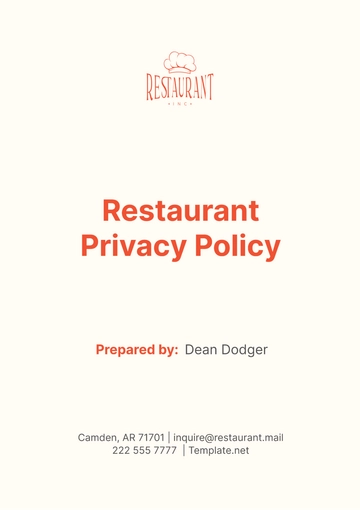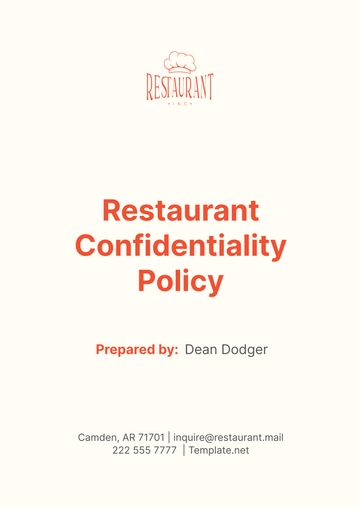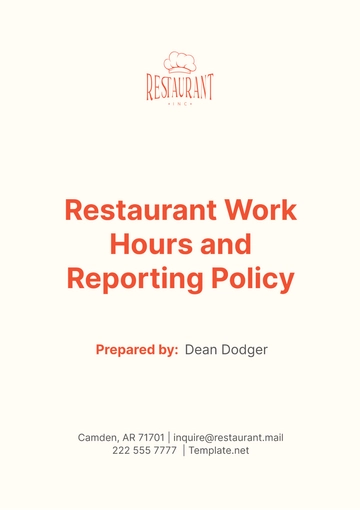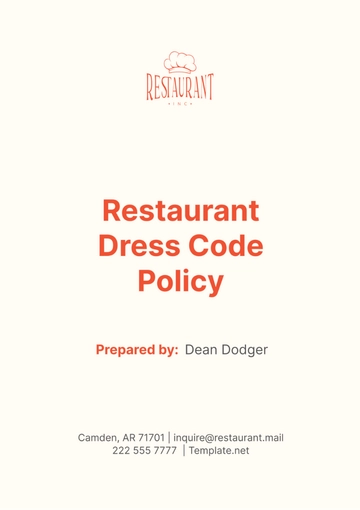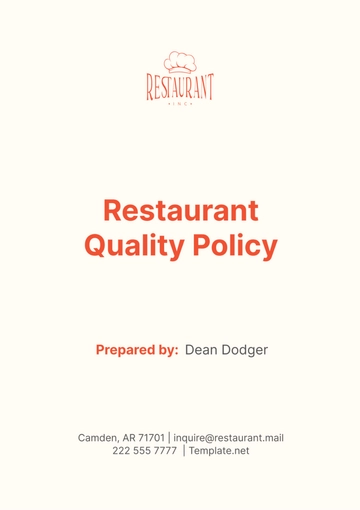Free Restaurant Sexual Harassment Policy

I. Introduction
A. Purpose of the Policy
The purpose of this policy is to ensure that all employees, contractors, vendors, and customers at [Your Company Name] can work and interact in an environment free from sexual harassment. It outlines the procedures for reporting and addressing incidents of harassment, ensuring fairness and protection for all parties involved.
This policy aims to promote a culture of respect and accountability, thereby enhancing the overall work experience and safety for everyone within the restaurant.
B. Statement of Commitment to a Harassment-Free Workplace
[Your Company Name] is unwavering in its commitment to maintaining a harassment-free workplace. We believe every individual has the right to work in a professional atmosphere that promotes equal opportunities and prohibits discriminatory practices.
We are dedicated to taking proactive measures to prevent harassment and to address any incidents that may occur swiftly and effectively.
C. Scope of the Policy
This policy applies to all employees, whether full-time, part-time, temporary, or seasonal, as well as independent contractors, vendors, customers, and any other individuals who interact with our restaurant.
It covers conduct occurring in the workplace, at work-related events, and off-site locations where work-related activities are conducted.
II. Definition of Sexual Harassment
A. Explanation of Sexual Harassment
Sexual harassment includes any unwelcome sexual advances, requests for sexual favors, or other verbal or physical conduct of a sexual nature when such conduct explicitly or implicitly affects an individual's employment, unreasonably interferes with an individual's work performance, or creates an intimidating, hostile, or offensive work environment.
This policy is designed to address both quid pro quo harassment, where job benefits are conditioned on sexual favors, and hostile work environment harassment, which involves severe or pervasive conduct that creates an uncomfortable work setting.
B. Examples of Prohibited Conduct
1. Verbal Harassment
This includes unwelcome comments about an individual's body or clothing, sexually explicit jokes, catcalling, and making sexual or discriminatory remarks about a person's gender.
Verbal harassment can also involve spreading rumors about a person's sex life or making derogatory comments related to gender identity or sexual orientation.
2. Physical Harassment
Physical harassment includes unwanted touching, such as hugging, patting, or pinching, as well as more overt acts like assault or physical intimidation.
Any form of physical conduct that is sexual in nature and unwelcome is prohibited, including blocking someone's path or making physical advances.
3. Visual Harassment
This encompasses the display of sexually explicit images, posters, or drawings in the workplace, as well as sending sexually suggestive emails, texts, or social media messages.
Visual harassment can also include leering or making obscene gestures towards another person.
4. Quid Pro Quo Harassment
Occurs when submission to sexual conduct is explicitly or implicitly made a condition of employment, promotion, or any other job benefit.
An example would be a manager offering an employee a promotion in exchange for sexual favors.
5. Hostile Work Environment
This type of harassment involves behavior that creates an intimidating, hostile, or offensive work environment, such as pervasive jokes of a sexual nature, inappropriate comments, or other conduct that affects an individual's ability to perform their job.
A hostile work environment can be created by anyone in the workplace, including supervisors, coworkers, or even customers.
III. Reporting Procedures
A. How to Report Sexual Harassment
1. Internal Reporting Channels
a. Direct Supervisor
Employees are encouraged to report incidents of sexual harassment to their direct supervisor as soon as possible. Supervisors are trained to handle such complaints with sensitivity and confidentiality.
b. Human Resources Department
Reports can also be made directly to the HR department. Employees can contact HR at [Your Company Number] for assistance in filing a complaint and receiving support throughout the process.
c. Designated Harassment Officer
A designated harassment officer is available to receive and address complaints. Employees can reach out to the harassment officer at [Officer's Number] for specialized support.
2. External Reporting Options
a. Equal Employment Opportunity Commission (EEOC)
Employees have the right to file a complaint with the EEOC if they believe their rights have been violated. The EEOC can be contacted at [EEOC Contact Information].
b. Local or State Agencies
Complaints can also be filed with relevant local or state agencies that handle workplace harassment cases. Information on these agencies can be found at [Agency Number].
B. Anonymous Reporting Mechanisms
Employees who wish to remain anonymous can use the [Your Company Name] anonymous reporting hotline at [Your Company Number] or the online reporting form available at [Your Company Website]. These channels ensure confidentiality and allow for the reporting of incidents without fear of identification.
Anonymous reports will be taken seriously and investigated to the fullest extent possible, given the available information.
C. No Retaliation Assurance
[Your Company Name] strictly prohibits retaliation against anyone who reports harassment or participates in an investigation. Retaliation includes any adverse action taken against an employee for filing a complaint or assisting in an investigation.
Any employee found to be engaging in retaliation will be subject to disciplinary action, up to and including termination.
IV. Investigation Process
A. Initial Review of Complaints
Upon receiving a complaint, the HR department or designated harassment officer will conduct an initial review to understand the nature of the complaint and determine the appropriate steps for investigation.
The initial review will involve a preliminary assessment of the facts and, if necessary, immediate measures to protect the complainant and prevent further harassment.
B. Investigation Procedures
1. Confidentiality Measures
All investigations will be conducted with the utmost confidentiality to protect the privacy of all parties involved. Information will be shared only on a need-to-know basis.
Both the complainant and the accused will be reminded of the importance of confidentiality throughout the investigation process.
2. Interviewing Parties Involved
The investigation will include interviews with the complainant, the accused, and any witnesses who may have relevant information. These interviews will be conducted impartially and documented thoroughly.
Both parties will have the opportunity to provide their account of the events and submit any evidence they believe is pertinent.
3. Gathering Evidence
Investigators will collect all relevant evidence, including emails, texts, physical evidence, and any other documentation that can support the investigation.
The aim is to gather a comprehensive view of the situation to make an informed decision.
C. Timelines for Investigation
Investigations will typically be completed within 30 days of receiving a complaint. In some cases, additional time may be required, and the parties will be informed of any delays.
Timely resolution is a priority to minimize workplace disruption and ensure swift justice.
D. Decision-Making and Resolution
After completing the investigation, a decision will be made based on the findings. Both the complainant and the accused will be informed of the outcome and any actions that will be taken.
Appropriate corrective actions will be implemented to address the issue and prevent future incidents.
V. Disciplinary Actions
A. Range of Disciplinary Measures
1. Warnings
Verbal or written warnings may be issued for minor infractions where the conduct does not warrant more severe discipline. This serves as an official notice to cease inappropriate behavior.
Written warnings will be documented in the employee’s personnel file.
2. Suspension
In cases of more serious misconduct, the offending employee may be suspended without pay. The duration of the suspension will depend on the severity of the harassment and previous conduct.
Suspension serves as a clear indicator that the behavior is unacceptable and provides time for the organization to consider further actions.
3. Termination
For severe or repeated violations, the employee may be terminated. This is the most serious form of disciplinary action and reflects the organization’s zero-tolerance policy for sexual harassment.
Termination decisions will be based on the findings of the investigation and the overall impact on the workplace.
B. Criteria for Determining Disciplinary Actions
The severity and frequency of the harassment, the impact on the victim and the workplace, and any prior incidents of misconduct will be considered when determining disciplinary actions.
The goal is to ensure that the response is appropriate to the offense and deters future violations.
C. Enforcement of Disciplinary Actions
Disciplinary actions will be enforced consistently and fairly, with all employees held to the same standards regardless of their position within the organization.
Enforcement will be documented, and follow-up measures will be taken to ensure compliance.
VI. Support for Victims
A. Counseling and Support Services
[Your Company Name] provides access to counseling services through the Employee Assistance Program (EAP). Employees can contact the EAP at [EAP Contact Information] for confidential support and counseling services.
These services are designed to help victims cope with the emotional impact of harassment and provide them with the tools they need to recover and move forward.
B. Options for Adjusting Work Assignments
Victims of harassment may request temporary adjustments to their work assignments, such as changing shifts or work locations, to ensure their comfort and safety while the investigation is ongoing.
Such adjustments will be made with the utmost consideration for the victim’s needs and without any negative impact on their employment status.
C. Ongoing Support and Follow-Up
Continuous support will be provided to victims even after the resolution of the complaint. Follow-up meetings will be scheduled to ensure their well-being and address any ongoing concerns.
The HR department will maintain regular contact with the victim to provide ongoing support and monitor their recovery process.
VII. Training and Prevention
A. Mandatory Training Programs
1. New Employee Orientation
All new employees will receive comprehensive training on the restaurant’s sexual harassment policy during their orientation. This training will cover definitions, examples of inappropriate behavior, reporting procedures, and the importance of maintaining a respectful workplace.
The orientation will also include interactive elements, such as role-playing scenarios, to ensure new hires understand how to recognize and respond to harassment.
2. Ongoing Annual Training
All employees are required to participate in annual refresher training sessions. These sessions will reinforce the key components of the sexual harassment policy and update employees on any changes to the policy or reporting procedures.
Annual training will also address any trends or issues observed in the workplace over the past year, promoting a proactive approach to prevention.
B. Specialized Training for Managers and Supervisors
Managers and supervisors will receive additional training on handling complaints, conducting investigations, and fostering a harassment-free environment. This training will equip them with the skills needed to respond appropriately to incidents and support their teams effectively.
Specialized training will also focus on leadership skills and the role of management in setting the tone for a respectful workplace culture.
C. Creating a Culture of Respect and Inclusivity
[Your Company Name] is committed to creating a culture where respect and inclusivity are integral to our daily operations. This includes promoting open communication, encouraging teamwork, and celebrating diversity.
Initiatives such as diversity workshops, team-building activities, and employee recognition programs will be implemented to foster a positive and inclusive work environment.
VIII. Non-Retaliation Policy
A. Protection Against Retaliation
[Your Company Name] strictly prohibits any form of retaliation against individuals who report sexual harassment or participate in an investigation. Retaliation includes adverse actions such as demotion, dismissal, salary reduction, or any other negative treatment.
Protecting employees from retaliation ensures they can come forward without fear, promoting a safer and more transparent workplace.
B. Reporting Retaliation
Employees who believe they have been subjected to retaliation are encouraged to report it immediately to the HR department or the designated harassment officer. Such reports will be treated with the same seriousness and confidentiality as harassment complaints.
Retaliation complaints will be investigated promptly to address any wrongful actions and provide necessary support to the affected employee.
C. Investigating and Addressing Retaliation Claims
Claims of retaliation will be thoroughly investigated, following similar procedures to those used for harassment investigations. This includes interviewing the complainant, the accused, and any witnesses, as well as reviewing relevant documentation.
If retaliation is confirmed, appropriate corrective actions will be taken against the responsible parties to prevent further incidents and rectify the situation for the complainant.
IX. Policy Communication
A. Dissemination of the Policy
1. Employee Handbooks
The sexual harassment policy will be included in the employee handbook, which is distributed to all employees upon hire. Employees are required to read and acknowledge their understanding of the policy.
Handbooks will be regularly updated to reflect any changes to the policy or related procedures.
2. Posters in Common Areas
Posters summarizing the sexual harassment policy, including key definitions and reporting procedures, will be displayed prominently in common areas such as break rooms and employee lounges.
These posters will serve as constant reminders of the policy and encourage a harassment-free workplace.
3. Intranet and Digital Platforms
The full policy will be accessible on the restaurant’s intranet or employee portal, allowing employees to review it at any time. Digital copies ensure that all staff, including remote or off-site workers, have easy access to the information.
Regular digital communications, such as emails or newsletters, will highlight important aspects of the policy and any updates.
B. Regular Policy Reviews and Updates
The policy will be reviewed annually by the HR department and legal advisors to ensure it remains effective and compliant with current laws. Employee feedback and incident trends will also be considered during reviews.
Any updates or changes to the policy will be communicated to all employees promptly, with additional training provided if necessary.
C. Acknowledgment of Receipt and Understanding by Employees
All employees will be required to sign an acknowledgment form upon receiving the policy, confirming they have read, understood, and agree to comply with it. This form will be kept in the employee’s personnel file.
Regular reminders will be issued to ensure ongoing awareness and compliance with the policy.
X. Review and Updates
A. Regular Review Schedule
The sexual harassment policy will undergo a formal review process annually. This ensures the policy remains current, effective, and aligned with legal standards and best practices.
The review will involve input from HR professionals, legal advisors, and employee representatives to provide a comprehensive assessment.
B. Process for Updating the Policy
Updates to the policy will be based on changes in laws, regulations, and feedback from employees and management. Any significant updates will be reviewed and approved by senior management before implementation.
Employees will be notified of updates through official communications, and training sessions will be provided to ensure understanding and adherence to the revised policy.
C. Employee Feedback Mechanism
Employees are encouraged to provide feedback on the policy at any time through [Feedback Mechanism Number]. This could be an anonymous suggestion box, an online feedback form, or direct communication with the HR department.
Feedback will be reviewed regularly and considered during the policy review process to ensure it addresses the needs and concerns of the workforce.
XI. Conclusion
A. Reaffirmation of Commitment to a Safe Workplace
[Your Company Name] reaffirms its unwavering commitment to providing a safe, respectful, and harassment-free workplace for all employees, customers, and stakeholders. We believe that maintaining a positive work environment is essential to the success and well-being of everyone.
B. Encouragement for Employees to Report Issues
Employees are strongly encouraged to report any incidents of sexual harassment or related concerns without fear of retaliation. Open communication and prompt reporting are critical to maintaining a safe workplace and addressing issues effectively.
C. Contact Information for Further Assistance
For further assistance or to report an incident, employees can contact the HR department at [Your Company Number] or the designated harassment officer at [Harassment Officer Number]. Additional support resources and contact information are available in the employee handbook and on the company intranet.
- 100% Customizable, free editor
- Access 1 Million+ Templates, photo’s & graphics
- Download or share as a template
- Click and replace photos, graphics, text, backgrounds
- Resize, crop, AI write & more
- Access advanced editor
Improve your restaurant's workplace environment with Template.net's Restaurant Sexual Harassment Policy Template. This editable and customizable template, crafted with precision, ensures comprehensive coverage and compliance. Easily tailor it to your specific needs using our AI Editor Tool, ensuring a respectful, safe, and professional workplace for all employees. Get started today on Template.net!
You may also like
- HR Policy
- Restaurant Policy
- Company Policy
- Accounting Policies and Procedures
- Website Policy
- Privacy Policy
- Safety Policy
- School Policy
- IT and Software Policy
- Law Firm Policy
- Construction Policy
- Interior Design Policy
- Travel Agency Policy
- Education Academic Policy
- Security Policy
- Real Estate Policy
- Expense Policy
- Software Policy






